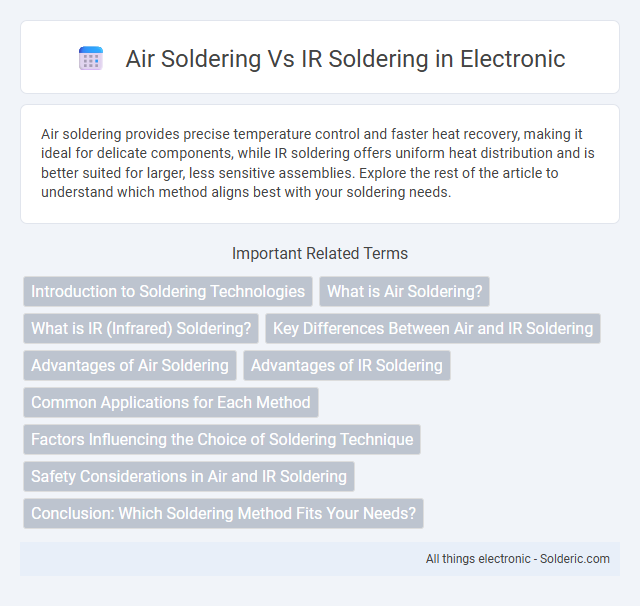Air soldering provides precise temperature control and faster heat recovery, making it ideal for delicate components, while IR soldering offers uniform heat distribution and is better suited for larger, less sensitive assemblies. Explore the rest of the article to understand which method aligns best with your soldering needs.
Comparison Table
| Feature | Air Soldering | IR Soldering |
|---|---|---|
| Heat Source | Hot air flow | Infrared radiation |
| Heating Method | Convection heating | Radiation heating |
| Temperature Control | Precise, adjustable airflow and temp | Controlled IR intensity and wavelength |
| Heating Uniformity | Less uniform, may cause component shifting | More uniform, better for delicate components |
| Typical Applications | Rework, small PCB soldering | Mass soldering, complex assemblies |
| Component Sensitivity | Higher risk of component displacement | Gentle on sensitive parts |
| Setup Complexity | Simple, portable tools | Requires specialized IR equipment |
| Cost | Lower initial investment | Higher initial investment |
| Process Speed | Moderate speed | Faster for batch soldering |
Introduction to Soldering Technologies
Air soldering utilizes a directed stream of heated air to precisely melt solder, enabling efficient temperature control and minimal thermal stress on components. Infrared (IR) soldering employs infrared radiation to uniformly transfer heat to the solder joint, providing consistent energy absorption and reduced oxidation. Both technologies optimize soldering workflows in electronics manufacturing by enhancing precision and reliability.
What is Air Soldering?
Air soldering is a precise thermal process that uses a controlled stream of hot air to melt solder, enabling the joining of electronic components on circuit boards without direct contact. This technique offers rapid heating and cooling cycles, reducing thermal stress on sensitive parts and promoting solder joint reliability. Your assembly gains improved flexibility and efficiency, especially in rework or repair tasks where delicate temperature control is crucial.
What is IR (Infrared) Soldering?
IR (Infrared) soldering utilizes infrared radiation to heat the solder and components directly without contacting the workpiece, allowing precise temperature control and uniform heat distribution. This method enhances solder joint quality by minimizing thermal stress and damage to sensitive electronic parts. IR soldering is widely preferred in surface-mount technology (SMT) assembly for its efficiency and reliability compared to conventional air soldering techniques.
Key Differences Between Air and IR Soldering
Air soldering uses heated compressed air to transfer heat, enabling precise temperature control and uniform heat distribution on complex components, while IR soldering relies on infrared radiation to directly heat the solder joint, offering faster processing but less localized control. Air soldering excels in delicate applications with sensitive components due to its gentle and adjustable heat application, whereas IR soldering is suitable for rapid soldering of larger batches with simpler geometries. The choice between air and IR soldering depends on factors such as component heat sensitivity, production volume, and required process precision.
Advantages of Air Soldering
Air soldering offers precise temperature control, reducing thermal stress on sensitive electronic components and enhancing joint quality. It provides rapid heating and cooling cycles, improving production efficiency and minimizing the risk of damage. Your manufacturing process benefits from its compatibility with various soldering alloys and parts, ensuring versatility and reliability in electronic assembly.
Advantages of IR Soldering
IR soldering offers precise heat control, reducing the risk of thermal damage to sensitive components in electronic assemblies. This method ensures uniform heat distribution across the PCB, enhancing solder joint quality and reliability. Its non-contact nature minimizes contamination and mechanical stress, making it ideal for delicate or complex circuit boards.
Common Applications for Each Method
Air soldering is commonly used for precision electronics assembly, including printed circuit boards (PCBs) and delicate semiconductor components, due to its ability to provide controlled, localized heat. IR soldering is preferred in applications requiring uniform heat distribution such as soldering of surface mount devices (SMDs) and reflow soldering in mass production of electronic assemblies. Both methods are essential in electronics manufacturing, with air soldering excelling in repair and hobbyist settings, while IR soldering is suited for automated, high-volume production environments.
Factors Influencing the Choice of Soldering Technique
The choice between air soldering and IR soldering depends on factors such as the type of components, thermal sensitivity, and production volume. Air soldering offers precise temperature control ideal for delicate or small-scale electronic assemblies, while IR soldering provides uniform heat distribution suitable for larger or densely packed components. Your decision should consider these parameters alongside equipment cost and process speed to optimize soldering quality and efficiency.
Safety Considerations in Air and IR Soldering
Air soldering involves hot air that can pose burn risks and requires proper ventilation to avoid inhaling flux fumes. IR soldering uses infrared radiation, which reduces direct exposure to hot air but demands caution to prevent eye damage from intense IR light. Your safety gear should include heat-resistant gloves and protective eyewear for both methods to minimize injury.
Conclusion: Which Soldering Method Fits Your Needs?
Air soldering offers precise temperature control and rapid heat response, making it ideal for delicate components and intricate PCB work. IR soldering provides uniform heat distribution suitable for larger assemblies but may risk thermal damage to sensitive parts. Your choice depends on the complexity of your project and heat sensitivity of the components you are working with.
Air soldering vs IR soldering Infographic

 solderic.com
solderic.com